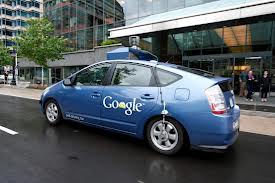By Rose O. Sherman, RN, EdD, FAAN
 Dr. Tim Porter O’Grady always urges nurse leaders to study the “signposts of change” to plan for the future. One such signpost is the interesting new innovation of the driverless car. This innovation is being led by engineers at Google which have developed the technology for autonomous cars. The driverless cars are currently being tested in collaboration with automakers and it is anticipated that it will come on the market as early as 2020. Three states (Nevada, Florida and California) have already passed legislation allowing the operation of autonomous cars on their highways. In August 2012, the team announced that they have completed over 300,000 autonomous-driving miles (500 000 km) accident-free, typically have about a dozen cars on the road at any given time. This technology is potentially a disruptive innovation that could impact a wide range of industries including healthcare.
Dr. Tim Porter O’Grady always urges nurse leaders to study the “signposts of change” to plan for the future. One such signpost is the interesting new innovation of the driverless car. This innovation is being led by engineers at Google which have developed the technology for autonomous cars. The driverless cars are currently being tested in collaboration with automakers and it is anticipated that it will come on the market as early as 2020. Three states (Nevada, Florida and California) have already passed legislation allowing the operation of autonomous cars on their highways. In August 2012, the team announced that they have completed over 300,000 autonomous-driving miles (500 000 km) accident-free, typically have about a dozen cars on the road at any given time. This technology is potentially a disruptive innovation that could impact a wide range of industries including healthcare.
How it Works
Chaitanya Gudipaty provides a description for how the technology works – “On the car’s roof is a rotating sensor known as LIDAR (laser radar). It uses lasers to scan up to up to 200 feet in every direction to create a 3D image of the car’s surroundings. A range finder mounted on the rooftop is a Velodyne 64-beam laser which is an obstacle detector and navigator. A sensor is located on the left rear-wheel that tracks the car’s movement and updates its location on a map constantly. There are four radar – three in the front and one at the rear determine the distance and position of vehicles and objects in the vicinity. A video camera is fitted to the car’s rear-view mirror that helps computers onboard detect, distinguish and recognize moving objects such as other cars, pedestrians and bikers. It also relays traffic-light information to computers.”
The Challenges
Interestingly, one of the biggest challenges in bringing driverless cars to the market especially in the United States will be the issue of liability. Unlike our current automobile insurance policies, Megan McArdle points out the issues of liability if something does go wrong are very complex – involving the individual, the auto company and even Google. She points out that even if the overall number of accidents drops, the number of accidents where the automaker is perceived to be at fault will approach 100 percent. After all, they’re the ones who designed or installed the software that made the decision. There is high risk with this disruptive innovation but at some point, the gains will outweigh the risks. Despite the challenges, virtually all the major automobile manufacturers are moving forward with development of the technology.
Possible Impact on the Healthcare System
There are ripple effects for every industry including healthcare. It is estimated that if the technology is widely implemented then there could be a reduction of up to 90% of auto accidents. The World Health Organization estimates that road traffic injuries will become the fifth leading cause of worldwide death by 2030, accounting for 3.6% of the total—rising from the ninth leading cause in 2004, when it accounted for 2.2% of the world total. Currently, there are more that 5 million automobile accidents each year in the United States. More than two million of these accidents involve injuries where patients are seen in emergency rooms and often admitted to hospitals. Emergency rooms could lose millions of patients a year, and hospitals would have hundreds of thousands fewer people who needed to stay overnight. Both Trauma and rehabilitation centers could experience significant changes in patient volume. Health insurers would have to give up revenue as car-related injuries plummet.
On the flip side, this technology has the power to keep an aging and or disabled population independent in their homes for much longer periods of time even if they cannot drive. When nurse leaders plan for the follow-up care of high risk patients – this technology could be very powerful in ensuring that patients keep their appointments if it includes sending them a car to pick them up.
This is a signpost that is worth watching. In a seven-part series for Forbes magazine, Chunka Mui points out that despite the challenges, these disruptive changes could happen very rapidly as the innovation gathers momentum. He advises caution to those who believe that the downstream effects are years away.
Read to Lead
Steve Mahan (2012): Self-driving Car Test Google YouTube
Porter-O’Grady, T.& Malloch, K. (2011). Quantum Leadership. Sudbury, MA: Jones and Bartlett.
© emergingrnleader.com 2013


 LinkedIn
LinkedIn Instagram
Instagram